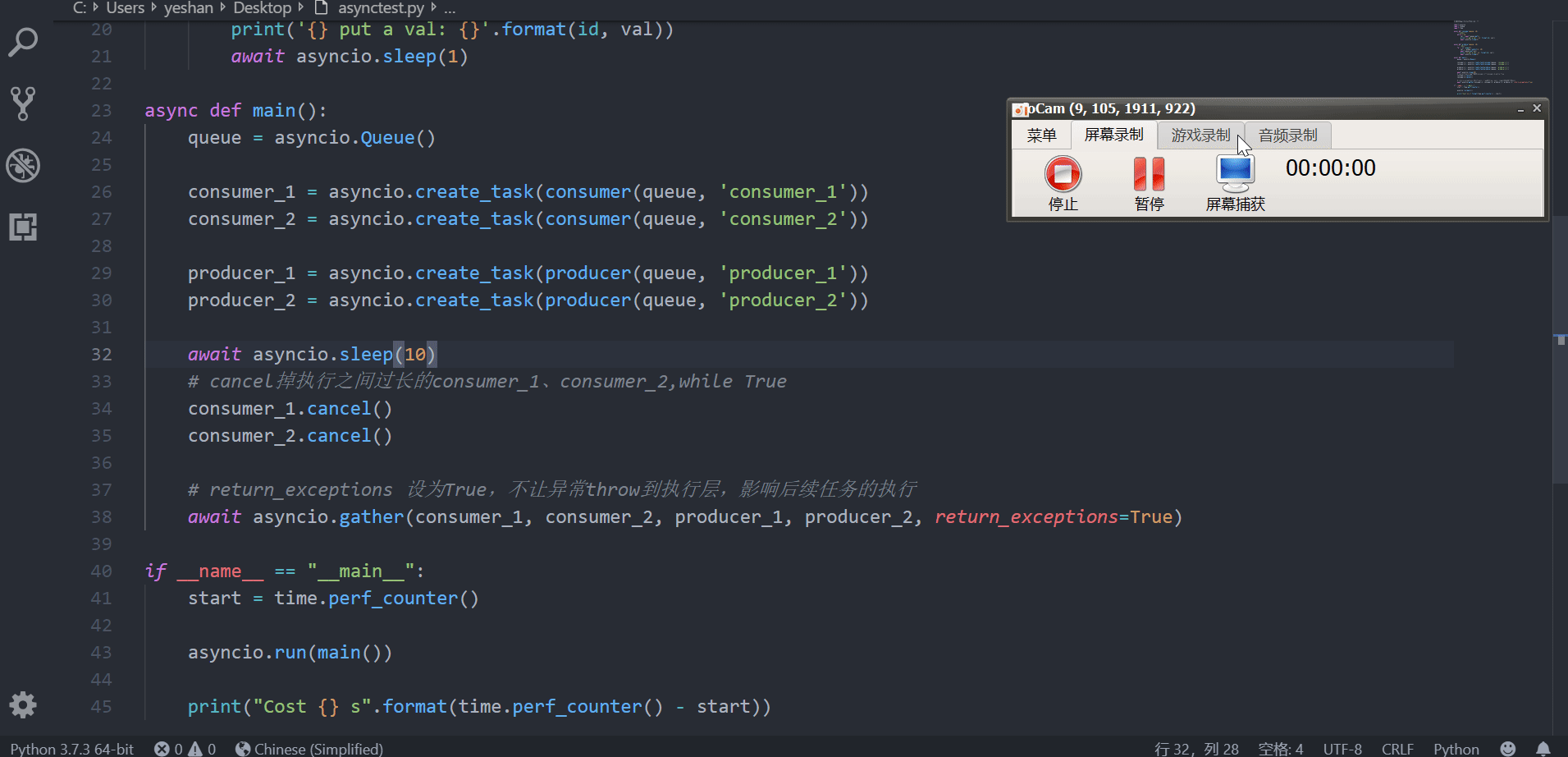Python协程-asyncio、async/await
看到吐血 (´ཀ`」 ∠)
协程(Coroutine)本质上是一个函数,特点是在代码块中可以将执行权交给其他协程
众所周知,子程序(函数)都是层级调用的,如果在A中调用了B,那么B执行完毕返回后A才能执行完毕。协程与子程序有点类似,但是它在执行过程中可以中断,转而执行其他的协程,在适当的时候再回来继续执行。
协程与多线程相比的最大优势在于:协程是一个线程中执行,没有线程切换的开销;协程由用户决定在哪里交出控制权
这里用到的是asyncio库(Python 3.7),这个库包含了大部分实现协程的魔法工具
使用 async 修饰词声明异步函数
使用 await 语句执行可等待对象(Coroutine、Task、Future)
使用 asyncio.create_task 创建任务,将异步函数(协程)作为参数传入,等待event loop 执行
使用 asyncio.run 函数运行协程程序,协程函数作为参数传入
解析协程运行时
1 2 3 4 5 6 7 8 9 10 11 12 13 14 15 16 17 18 19 20 21 22 23 24 25 26 27 28 import asyncioimport timeasync def a (): print ("欢迎使用 a !" ) await asyncio.sleep(1 ) print ("欢迎回到 a !" ) async def b (): print ("欢迎来到 b !" ) await asyncio.sleep(2 ) print ("欢迎回到 b !" ) async def main (): task1 = asyncio.create_task(a()) task2 = asyncio.create_task(b()) print ("准备开始" ) await task1 print ("task1 结束" ) await task2 print ("task2 结束" ) if __name__ == "__main__" : start = time.perf_counter() asyncio.run(main()) print ('花费 {} s' .format (time.perf_counter() - start))
解释:
1、asyncio.run(main()),程序进入main()函数,开启事件循环
2、创建任务task1、task2并进入事件循环等待运行
3、输出准备开始
4、执行await task1,用户选择从当前主任务中切出,事件调度器开始调度 a
5、a 开始运行,输出欢迎使用a!,运行到await asyncio.sleep(1),从当前任务切出,事件调度器开始调度 b
6、b 开始运行,输出欢迎来到b!,运行到await asyncio.sleep(2),从当前任务切出
7、以上事件运行时间非常短(毫秒),事件调度器开始暂停调度
8、一秒钟后,a的sleep完成,事件调度器将控制权重新交给a ,输出欢迎回到a!,task1完成任务,退出事件循环
9、await task1完成,事件调度器将控制权还给主任务,输出task1结束,然后在await task2处继续等待
10、两秒钟后,b的sleep完成,事件调度器将控制权重新传给 b ,输出欢迎回到 b!,task2完成任务,从事件循环中退出
11、事件调度器将控制权交还给主任务,主任务输出task2结束,至此协程任务全部结束,事件循环结束。
上面的代码也可以这样写,将15到21行换成一行await asyncio.gather(a(), b())也能实现类似的效果 ,await asyncio.gather 会并发运行传入的可等待对象(Coroutine、Task、Future)。
1 2 3 4 5 6 7 8 9 10 11 12 13 14 15 16 17 18 19 20 21 22 import asyncioimport timeasync def a (): print ("欢迎使用 a !" ) await asyncio.sleep(1 ) print ("欢迎回到 a !" ) async def b (): print ("欢迎来到 b !" ) await asyncio.sleep(2 ) print ("欢迎回到 b !" ) async def main (): await asyncio.gather(a(), b()) if __name__ == "__main__" : start = time.perf_counter() asyncio.run(main()) print ('花费 {} s' .format (time.perf_counter() - start))
异步接口同步实现
1 2 3 4 5 6 7 8 9 10 11 12 13 14 15 16 17 18 19 20 21 22 23 24 25 """ - 简单爬虫模拟 - 这里用异步接口写了个同步代码 """ import asyncioimport timeasync def crawl_page (url ): print ('crawling {}' .format (url)) sleep_time = int (url.split('_' )[-1 ]) await asyncio.sleep(sleep_time) print ('OK {}' .format (url)) async def main (urls ): for url in urls: await crawl_page(url) start = time.perf_counter() asyncio.run(main(['url_1' , 'url_2' ])) print ("Cost {} s" .format (time.perf_counter() - start))
使用 Task 实现异步
1 2 3 4 5 6 7 8 9 10 11 12 13 14 15 16 17 18 19 20 21 22 23 import asyncioimport timeasync def crawl_page (url ): print ('crawling {}' .format (url)) sleep_time = int (url.split('_' )[-1 ]) await asyncio.sleep(sleep_time) print ('OK {}' .format (url)) async def main (urls ): tasks = [asyncio.create_task(crawl_page(url)) for url in urls] for task in tasks: await task start = time.perf_counter() asyncio.run(main(['url_1' , 'url_2' ])) print ("Cost {} s" .format (time.perf_counter() - start))
生产者消费者模型的协程版本
1 2 3 4 5 6 7 8 9 10 11 12 13 14 15 16 17 18 19 20 21 22 23 24 25 26 27 28 29 30 31 32 33 34 35 36 37 38 39 40 41 42 43 44 45 import asyncioimport randomimport timeasync def consumer (queue, id ): """消费者""" while True : val = await queue.get() print ('{} get a val : {}' .format (id , val)) await asyncio.sleep(1 ) async def producer (queue, id ): """生产者""" for _ in range (5 ): val = random.randint(1 , 10 ) await queue.put(val) print ('{} put a val: {}' .format (id , val)) await asyncio.sleep(1 ) async def main (): queue = asyncio.Queue() consumer_1 = asyncio.create_task(consumer(queue, 'consumer_1' )) consumer_2 = asyncio.create_task(consumer(queue, 'consumer_2' )) producer_1 = asyncio.create_task(producer(queue, 'producer_1' )) producer_2 = asyncio.create_task(producer(queue, 'producer_2' )) await asyncio.sleep(10 ) consumer_1.cancel() consumer_2.cancel() await asyncio.gather(consumer_1, consumer_2, producer_1, producer_2, return_exceptions=True ) if __name__ == "__main__" : start = time.perf_counter() asyncio.run(main()) print ("Cost {} s" .format (time.perf_counter() - start))
1 2 3 4 5 6 7 8 9 10 11 12 13 14 15 16 17 18 19 20 21 22 # 输出结果 producer_1 put a val: 7 producer_2 put a val: 4 consumer_1 get a val : 7 consumer_2 get a val : 4 producer_1 put a val: 6 producer_2 put a val: 1 consumer_2 get a val : 6 consumer_1 get a val : 1 producer_1 put a val: 8 producer_2 put a val: 1 consumer_1 get a val : 8 consumer_2 get a val : 1 producer_1 put a val: 6 producer_2 put a val: 4 consumer_2 get a val : 6 consumer_1 get a val : 4 producer_1 put a val: 7 producer_2 put a val: 8 consumer_1 get a val : 7 consumer_2 get a val : 8 Cost 10.0093015 s
拓展阅读:Python的生产者消费者模型,看这篇就够了
参考




